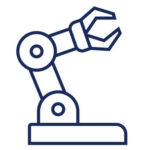We aim to deliver a step-change in robotics capabilities for asset management. Enabling reliable, robust and safe autonomous inspection and maintenance of large complex structures in challenging environments.
Our research program’s design makes an innovative and original distinction between fundamental research themes (Robotics Research Program) and capabilities (Robot Capabilities).
These capabilities will be the Hub’s central “output”; and focusing on them, rather than on the often-siloed research disciplines of robotics, is what will drive the Hub’s most important innovations.
Linking capabilities and fundamental research themes through iterative feedback loops, the Hub will develop:
 Innovative planning and control algorithms that consider the challenges of perception and the needs of mapping and insights
Innovative planning and control algorithms that consider the challenges of perception and the needs of mapping and insights

Innovative sensing and perception technologies that benefit through interaction with the environment (typically the domain of planning and control)
![]()
Innovative techniques for spatio-temporal mapping and generating insights to inform planning, optimisation and control through accurate quantification of uncertainty and dynamic representations of the environment
This approach, together with our industry-oriented proof-of-concept capability demonstrators, will ensure a deeply integrated program of work that breaks down the barriers between academia and industry, and cuts across disciplines within robotics and planning, none of which can solve these problems on its own.
Mobile robots and digital twins
The central concept is of mobile robots tightly integrated with a digital twin. A digital twin is a dynamic, virtual representation of a corresponding physical asset. While it is common for a digital representation, such as a computer-aided-design (CAD) model, to be created during the design and construction of an asset, a digital twin differs in that it presents real-time information throughout the asset’s lifecycle that can be used to understand ongoing changes, such as corrosion or fatigue, and to optimize inspection and maintenance schedules. The real-time element requires the continuous collection and integration of sensor data, but with fixed sensors this is often infeasible due to the scale and complexity of assets.
Mobile robotic systems therefore hold the key: they can move around to inspect assets and collect data that informs and updates the digital twin; conversely the digital twin informs the robot’s inspection planning process to maximise the value of the data collected.
Intelligent robotic systems partnered with digital twins hold exceptional promise for transforming the way assets and infrastructure are managed. However, there are deep scientific challenges that need to be resolved before this promise can be realised. Better capabilities are required in mission planning, navigation and control, perception, and mapping. Our team will work together to advance the fundamental science, technological development, and industry impact of intelligent robotic systems for asset management.